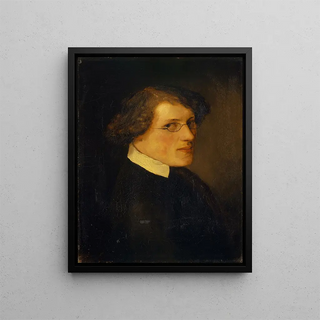Painting Portrait of Jakob Mühly - Arnold Böcklin | Art print


View from behind

Frame (optional)
Reproduction Portrait of Jakob Mühly - Arnold Böcklin – Captivating Introduction
The "Portrait of Jakob Mühly" by Arnold Böcklin is a work that transcends the simple framework of a pictorial representation. This painting, imbued with a mystical atmosphere, immerses us in a universe where the psychology of the characters blends with symbolic nature. Through this portrait, Böcklin does not merely capture the physical appearance of his model but also explores the depths of the human soul. The viewer's gaze is immediately drawn to the depth of Jakob Mühly's eyes, which seem to tell a story far greater than that of the individual depicted. This work, both intimate and universal, invites contemplation and reflection on the human condition.
Style and uniqueness of the work
Arnold Böcklin's style is characterized by a harmonious fusion of realism and symbolism. In the "Portrait of Jakob Mühly," facial features are rendered with meticulous precision, while the blurred background evokes an atmosphere of mystery. The colors, carefully chosen, create a rich and nuanced palette that enhances the subject's emotions. Light plays a crucial role, highlighting certain parts of the face while leaving others in shadow, which reinforces the enigmatic nature of the portrait. Jakob Mühly's posture, both relaxed and alert, suggests deep introspection, an invitation to delve into his thoughts. This painting thus stands out for its ability to capture not only the image of a man but also the very essence of his being.
The artist and his influence
Arnold Böcklin, a Swiss painter of the 19th century, is often regarded as one of the pioneers of symbolism. His ability to marry the real world with fantastic elements marked his era and continues to influence many contemporary artists. Böcklin mastered creating a unique visual language, where each work becomes an entry point into deeper reflections on life, death, and the beyond. His exploration of mythological and psychological themes, as well as his bold use of color and light, established new standards in the field of painting. The "Portrait of Jakob"

Matte finish

View from behind

Frame (optional)
Reproduction Portrait of Jakob Mühly - Arnold Böcklin – Captivating Introduction
The "Portrait of Jakob Mühly" by Arnold Böcklin is a work that transcends the simple framework of a pictorial representation. This painting, imbued with a mystical atmosphere, immerses us in a universe where the psychology of the characters blends with symbolic nature. Through this portrait, Böcklin does not merely capture the physical appearance of his model but also explores the depths of the human soul. The viewer's gaze is immediately drawn to the depth of Jakob Mühly's eyes, which seem to tell a story far greater than that of the individual depicted. This work, both intimate and universal, invites contemplation and reflection on the human condition.
Style and uniqueness of the work
Arnold Böcklin's style is characterized by a harmonious fusion of realism and symbolism. In the "Portrait of Jakob Mühly," facial features are rendered with meticulous precision, while the blurred background evokes an atmosphere of mystery. The colors, carefully chosen, create a rich and nuanced palette that enhances the subject's emotions. Light plays a crucial role, highlighting certain parts of the face while leaving others in shadow, which reinforces the enigmatic nature of the portrait. Jakob Mühly's posture, both relaxed and alert, suggests deep introspection, an invitation to delve into his thoughts. This painting thus stands out for its ability to capture not only the image of a man but also the very essence of his being.
The artist and his influence
Arnold Böcklin, a Swiss painter of the 19th century, is often regarded as one of the pioneers of symbolism. His ability to marry the real world with fantastic elements marked his era and continues to influence many contemporary artists. Böcklin mastered creating a unique visual language, where each work becomes an entry point into deeper reflections on life, death, and the beyond. His exploration of mythological and psychological themes, as well as his bold use of color and light, established new standards in the field of painting. The "Portrait of Jakob"
12,34 €






